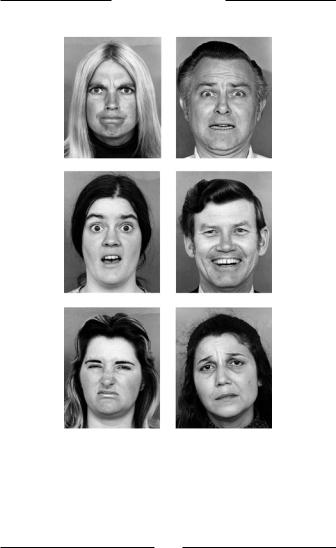
Books on Happiness / Happiness_ The Science Behind Your Smile
.pdf
INTRODUCTION
decisions. If maximizing happiness is the point of individual lives, then the point of systems of government and economy should be to maximize collective or aggregate happiness. This position is a pure form of the doctrine of Utilitarianism, which was made famous by moral philosopher Jeremy Bentham (1748–1832), but foreshadowed in the thought of Francis Hutcheson who claimed, ‘That action is best, which procures the greatest happiness for the greatest numbers’.
This form of utilitarianism has an enduring appeal. The government of the Himalayan kingdom of Bhutan recently announced that the goal of public policy there would be to increase not the Gross National Product, but the Gross National Happiness. The Bhutanese are obviously on to something. Happy people live longer than unhappy people and are less vulnerable to disease. And there are enduring differences in happiness between nations, between the rich and the poor, and between the married and the single. However enlightened it may seem, though, the Bhutanese strategy immediately raises questions. Can people’s happiness actually be changed by public action? Come to think of it, can it be changed by any means at all? If so, how? And how should we assess the Gross National Happiness?
The early Utilitarians had recognized that implementing their programme required a device for meas-
2

INTRODUCTION
uring happiness—a hedonimeter. No such device exists, of course. We can ask people how happy they feel. This turns out to be a surprisingly revealing exercise, as we shall see. However, happiness has multiple senses. Its function in the sentence, ‘I was happy to see Bob’, may be rather different from that in the sentence, ‘I was happy with the foreign policy of the government’. So before we could use judgements of happiness as a touchstone for public life, we would need to undertake a great deal of empirical work on people’s thoughts and feelings about happiness, and how the feeling of happiness relates to the quality of life. This is work that psychologists have begun over the last few decades, and its illuminating results will be reviewed in this book.
In Chapter 1, we examine the concept of happiness and attempt to tease apart its various senses. Some varieties of happiness may be more measurable than others, and some, perhaps not the same ones, more worth pursuing. Chapter 2 examines the question of whether people are basically happy or basically unhappy, and why. Chapters 3 and 4 turn to the question of why some people seem to be happier than others: are people happy because good things happen to them, or do good things happen to them because they are happy? We shall see evidence that people’s enduring levels of happiness come at least as much
3

INTRODUCTION
from themselves and the way they think as they do from the objective facts of their circumstances. Chapter 5 turns to the brain systems underlying emotions and moods. The feeling of well-being emerges from the interplay of neural circuits that are the products of millions of years of evolution. In men as in mice, positive and negative emotions rely on separate, dedicated neural circuits, which respond to status, to threats, and to rewards in the environment. The systems controlling pleasure are not identical to those controlling desire. This is an important lesson; the psychology of aspiration is not that of satisfaction. We do not always want what we like or like what we want.
Chapter 6 considers the problem of how to be happier, from the kinds of remedies on offer to the ways in which they can work. Finally, Chapter 7 attempts to synthesize briefly what we know about the often paradoxical psychology of happiness, and consider why we might be set up the way that we are. We are designed not for happiness or unhappiness, but to strive for the goals that evolution has built into us. Happiness is a handmaiden to evolution’s purposes here, functioning not so much as an actual reward but as an imaginary goal that gives us direction and purpose. That goal may never get any nearer, but it may not need to. Jefferson’s fundamental right, after all, was not happiness itself,
4

INTRODUCTION
but the pursuit of happiness. Nothing, not even a Utopia, can necessarily make the pursuit of happiness a successful one that ends in capture. The best society can merely allow every individual to flourish in the pursuit. And, looked at in the right way, this may be enough. The book concludes with a discussion of the prospects for future happiness. We, in the developed world at least, are wealthier, healthier, and freer than ever before. To expect large gains in happiness to follow suit may be unrealistic, for reasons which will become clear. There is even evidence that certain types of unhappiness are on the rise, and we will consider why this may be.
The problem with the concept of happiness is trying to make it do enough without making it do too much. If we define it narrowly as a certain type of feeling or physiological state, then we can, in principle, measure it objectively, but it is too trivial a thing to be the foundation of all public life and private decisions. On the other hand, if we define it broadly as something like ‘the elements of the good life’, then it is so broad as to beg the question, and certainly too broad to be measured in national statistics. Yet we intuitively feel that there is something called happiness, something unitary but not trivial, concrete enough to strive for yet broad enough to be worth striving for. The pursuit of this familiar,
5

INTRODUCTION
obscure, paradoxical object of desire is the theme of this book. The concept of happiness is a bit like a mirage to social scientists—it shimmers on the horizon as an appealing object of study, but often has a tendency to slip away when it is most closely approached. In this mirage-like quality, as we shall see, it is much like happiness itself.
6

1
Comfort and joy
Ayou have to ask whether you are in it or not, you are probably not. Few of us much care to definet first glance, happiness seems a little like love: if
it, but by heaven, we know it when we see it. The subjective, fuzzy, vague feel of the concept meant that happiness was neglected in psychology for many decades. For example, the 1985 Penguin dictionary of psychology moves unfalteringly from haploid to haptic without any signs of regret (hedonic tone gets three lines a few pages later). Surely, psychologists must have thought, happiness is a kind of homespun, folk category of thing that may have a certain use in bar-room gossip, but has no place in scholarly research articles. Actually, I will argue quite the opposite; however hard we try to fill our scholarly discourse with more palatable sounding alternatives (utility, hedonic tone, subjective well-being, positive emotionality), we are actually talking about some aspect of what gets agonized over in ordinary conversation. We
7

COMFORT AND JOY
do ourselves a disservice if we try to obfuscate this in neologisms. That doesn’t mean that some conceptual tidying-up is out of place, though, as we shall see.
Early psychologists, like the reliably marvellous William James (1842–1910), brother of the novelist Henry James, had no doubt in their minds that psychology should be studied scientifically. However, they were also quite happy to take as the point of departure for the new science, everyday, folk psychological notions from their own lives, like love, happiness, faith, and so on. They are often misrepresented on this point as somehow knowing no better. The science of animal behaviour was in its infancy, so could not furnish a theoretical vocabulary to be borrowed for human psychology, and neuroscience scarcely existed. So they were before their time, stuck in some capacious armchair having to think about what people thought and felt until someone invented something better.
As soon as psychology could find ways of ditching armchair and bar-room notions, it did so. In the midtwentieth century, psychologists were much more at home discussing rates of eye-blinking than love or joy. In time, eye-blinking evolved into more sophisticated behavioural measures like tiny differences in reaction times to given stimuli, but no one was much interested in connecting these up to big, messy, everyday notions
8

COMFORT AND JOY
like happiness. Indeed, the folk psychology of ordinary conversation, which trades in beliefs, desires, and feelings, was thought of by professionals as simply bad psychology, which stood to psychological truth roughly as painting someone blue and doing a dance around them at sunrise stands to antibiotics.
The truth, though, is that William James’ desire to start from the notions of people’s everyday thinking about psychology actually had a positive reason behind it. James seems to have understood that doing psychology is really like doing anthropology, and any anthropologist worth his malaria tablets begins by finding out what the people he is studying think it is that they do. It doesn’t mean that they will turn out to be right, but how they think about their lives is an important part of the phenomenon under study.
Thus I would argue that if people spend a lot of their time thinking about the notion of happiness, then that is a pretty good reason for studying it. This is true whether or not they ever achieve it, and whether or not it can be given a water-tight definition. The ideas of happiness and its pursuit are part of the natural history of human beings, and so deserve their share of scientific attention.
Psychology has moved in this direction in an interesting way over the last few decades, and is probably closer
9

COMFORT AND JOY
to William James’ concerns now than it was for most of the intervening years. In particular, the ways that people report what they think and feel about behaviour are now worthy objects of study. This is especially true with respect to the emotions and moods, and to happiness, as we shall see.
There are several reasons for the change. The work of Paul Ekman, starting in the 1960s, has been particularly important for research in the emotions. Before Ekman, emotions seemed precisely the kind of vague, subjective folk notions that psychologists avoided like the plague. Ekman, however, decided to start with some anthropology (in so doing, interestingly, he was reviving the neglected work of that near contemporary of William James, Charles Darwin). He took photographs of (American) actors displaying various emotions. He then asked participants to identify which emotion the expression went with. Unsurprisingly, American participants were pretty good at recognizing the emotions. However, Ekman also took these photographs and showed them to members of the Dani ethnic group in remote Papua New Guinea. By and large they agreed with the Americans about which face goes with which emotion.
These results have been replicated in many cultures. Ekman’s work allowed the identification of a set of basic
10

COMFORT AND JOY
Fig. 1.1 Faces displaying basic emotions, used by Paul Ekman in his research. The emotions are anger, fear, surprise, joy, disgust, and sadness.
11
